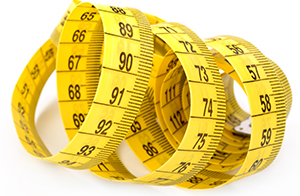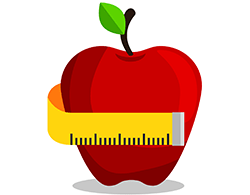
Measuring your waist
Why your waist size matters

Measuring your waist can help reduce your risk of heart and circulatory diseases, as Professor Naveed Sattar tells Senior Cardiac Nurse Emily McGrath.
Why does your waist measurement matter?
Waist circumference is a good measure of fat around your middle. This type of fat builds up around your organs, and is linked to high blood fat levels, high blood pressure and diabetes. A larger waist usually also means there is excess fat inside your organs. When this happens in your liver, for example, it pumps out too much fat and sugar into the blood, increasing your risk of coronary heart disease and diabetes.
Want to get fit and healthy?
Sign up to our fortnightly Heart Matters newsletter to receive healthy recipes, new activity ideas, and expert tips for managing your health. Joining is free and takes two minutes.
What should your waist measurement be?
For men, a waist circumference below 94cm (37in) is ‘low risk’, 94–102cm (37-40in) is ‘high risk’ and more than 102cm (40in) is ‘very high’. For women, below 80cm (31.5in) is low risk, 80–88cm (31.5-34.6in) is high risk and more than 88cm (34.6in) is very high. These are the guidelines for people of white European, black African, Middle Eastern and mixed origin.
For men of African Caribbean, South Asian, Chinese and Japanese origin, a waist circumference below 90cm (35.4in) is low risk, and more than that is ‘very high risk’ (there isn’t a ‘high risk’ category). For women from these groups, below 80cm (31.5in) is low risk, and anything above is very high risk.
Why does your ethnic origin make a difference?
African Caribbean, South Asian, Chinese and Japanese people tend to carry more fat and less muscle at the same weight as a white European. And the risk of diabetes and heart and circulatory diseases starts to increase at a lower weight gain than for Europeans.
Is this the best way to understand whether you are overweight?

It’s good because it’s easy to understand. Doctors are more likely to use body mass index (BMI), a measure of weight relative to your height – use our BMI calculator. Waist measurement is better for people who carry a lot of muscle and less fat, like bodybuilders, boxers and rugby players. If you want to eat more healthily and lose weight, it’s best to measure how much weight you lose or put on. Losing weight will help your waist measurement too.
- Use our new waist measurement tool.
- Try our BMI calculator.
- See the best ways to measure body fat.
How to measure your waist
- Find the bottom of your ribs and the top of your hips.
- Place a tape measure around your middle at a point halfway between them (just above the belly button).
- Make sure it’s pulled tight, but isn’t digging into your skin.
- Breathe out naturally and take your measurement.
- Take your measurement again, just to be sure.
Subscribe to News
Enter your email address to receive notifications of new posts by email.
- Sleep and Heart DiseaseMeasuring your waist can help reduce your risk of heart and circulatory diseases, as Professor Naveed Sattar tells Senior Cardiac Nurse Emily McGrath.
- What your resting heart rate says about youMeasuring your waist can help reduce your risk of heart and circulatory diseases, as Professor Naveed Sattar tells Senior Cardiac Nurse Emily McGrath.
- 5 risk factors for heart and circulatory disease – How to control themMeasuring your waist can help reduce your risk of heart and circulatory diseases, as Professor Naveed Sattar tells Senior Cardiac Nurse Emily McGrath.
- Measuring your waistMeasuring your waist can help reduce your risk of heart and circulatory diseases, as Professor Naveed Sattar tells Senior Cardiac Nurse Emily McGrath.

Hi, this is a comment.
To get started with moderating, editing, and deleting comments, please visit the Comments screen in the dashboard.
Commenter avatars come from Gravatar.